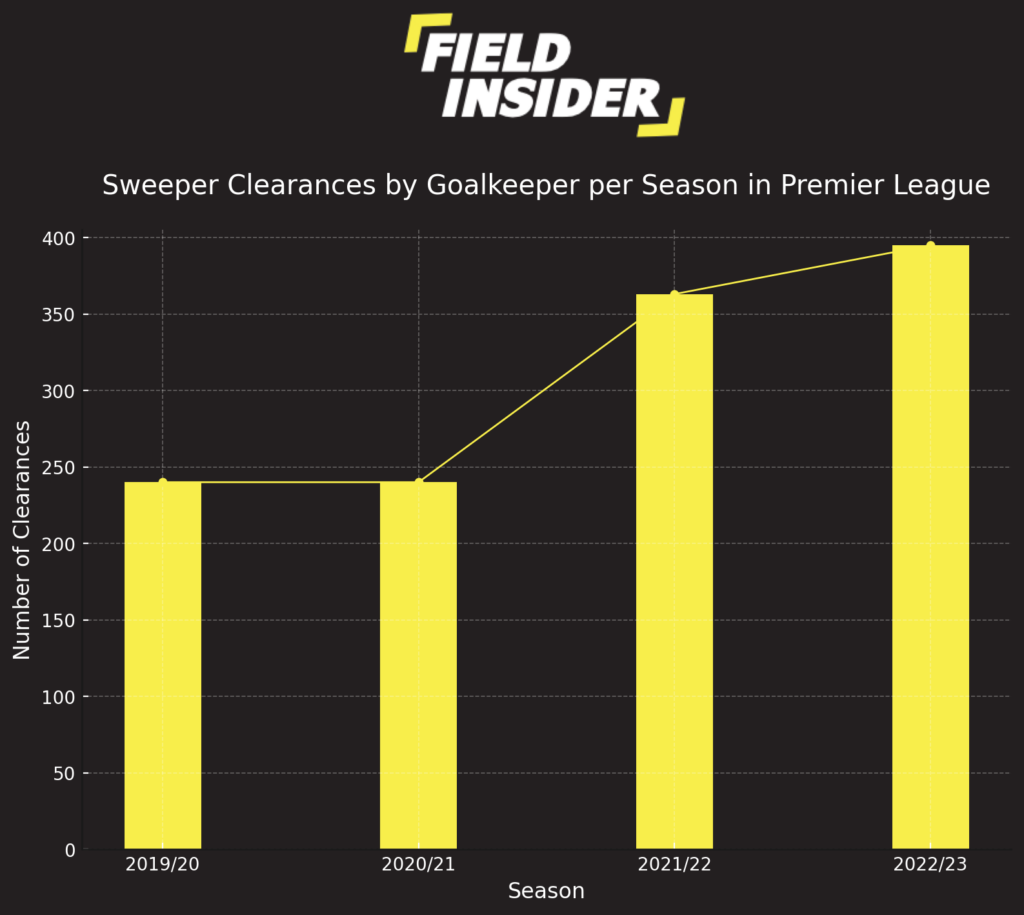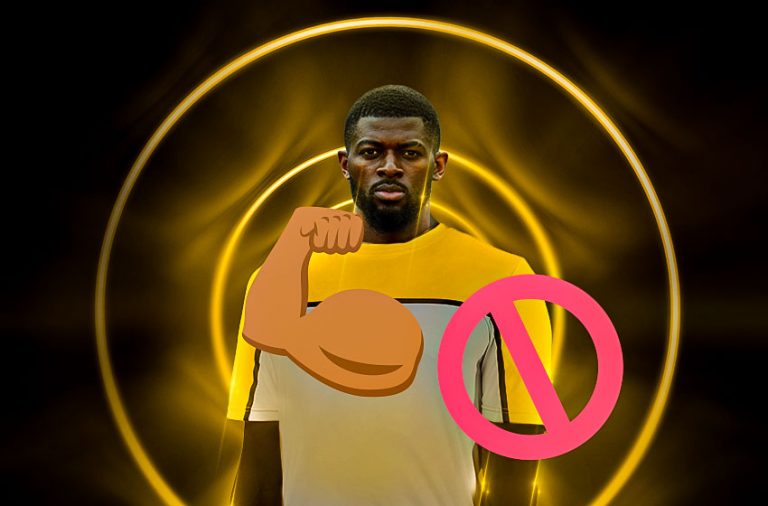The Sweeper Keeper: All You Need To Know
The concept of a “sweeper keeper” in football might sound like a modern invention, but it’s been evolving for decades. Unlike traditional goalkeepers, a sweeper keeper acts as the last line of defense and the first point of attack, bridging the gap between goalkeeping and outfield play.
This role is pivotal in the fluid, fast-paced nature of today’s football.
Key takeaways
| Key Takeaways | Details |
|---|---|
| Evolution of the Role | Transitioned from traditional shot-stopping goalkeepers to dynamic playmakers, significantly redefining the goalkeeper’s role in football. |
| Key Attributes | Essential skills include agility, game reading, precision in ball handling, and confidence in playing outside the box. |
| Tactical Influence | Sweeper keepers enable high defensive lines and contribute to building play from the back, adding a new dimension to team tactics. |
| Modern Exemplars | Goalkeepers like Alisson Becker and Ederson Moraes are prime examples of successful modern sweeper keepers, blending traditional goalkeeping with outfield skills. |
| Historical Impact | Pioneers like Lev Yashin set the foundation for this role, influencing football tactics and the role of the goalkeeper in the team structure. |
The Role of a Sweeper Keeper
A sweeper keeper is more than just a shot-stopper. They’re expected to read the game, clear balls outside the penalty area, and start attacks. This role differs significantly from a traditional goalkeeper, who focuses more on saving shots and less on playmaking.

Key Responsibilities
- Game Reading: A sweeper keeper must excel in anticipating the game’s flow, much like a ball-playing defender. This involves an acute understanding of game tactics and player movements.
- Ball Clearing: Their role extends outside the penalty area, clearing balls that breach the defense, requiring skills akin to those taught in defensive football positions.
- Initiating Attacks: A sweeper keeper’s skill in launching counter-attacks aligns with tactics used in 5-a-side attacking, where quick transitions are crucial.
Contrasts with Traditional Goalkeepers
- Positioning and Mobility: Traditional goalkeepers, usually confined to their penalty box and focusing on shot-stopping, contrast with the mobility of a sweeper keeper, who often ventures out, similar to tactics in a 3-4-3 formation.
- Footwork and Ball Handling: The footwork required by a sweeper keeper resembles the skills needed by an outfield player, focusing on ball control and passing, unlike the traditional goalkeeper.
- Tactical Role: The reactive nature of traditional goalkeepers differs significantly from the proactive, game-shaping role of a sweeper keeper, essential in strategies like building play from the back.
Evolution of the Sweeper Keeper
From the pioneering days of Lev Yashin to modern icons like Manuel Neuer, the sweeper keeper has transformed significantly. The evolution of this role has impacted football tactics, making the game faster and more dynamic.
Historical Context
- The Yashin Era: Lev Yashin, known as the “Black Spider,” revolutionized goalkeeping in the 20th century. His proactive style, venturing beyond the goal line to intercept attacks, laid the groundwork for future sweeper keepers.
- Renaissance in Tactics: The sweeper keeper role evolved as tactics shifted towards more fluid and dynamic styles. This change aligns with the evolution of football formations, from rigid structures to more flexible systems.
Modern Icons
- Manuel Neuer’s Influence: Neuer’s style is a blend of traditional goalkeeping and outfield skills, a perfect embodiment of the sweeper keeper. His ability to read the game and contribute to his team’s attacking play mirrors tactics employed in building play from the back.
- Contemporary Tactics: Modern football, with its emphasis on possession and high pressing, such as gegenpressing, necessitates goalkeepers who can act as an 11th outfield player, adept in both stopping goals and initiating attacks.
Impact in the game
- Faster, More Dynamic Play: The sweeper keeper role has been instrumental in making the game faster and more dynamic. This role demands skills that overlap with football training, focusing on agility, game reading, and ball handling.
- Tactical Flexibility: Teams have become more tactically flexible, often switching formations mid-game, as seen in the 3-3-4 formation or 4-3-3 formation, enabled in part by the versatility of the sweeper keeper.
Key Attributes of a Sweeper Keeper
The role of a sweeper keeper demands a unique set of skills, blending traditional goalkeeping with outfield playing abilities. This multifaceted position requires more than just shot-stopping.

Agility
Agility is a foundation for a sweeper keeper. They must be quick and nimble, not just in diving for saves but also in moving out of the box to intercept or clear balls.
Game Reading
The ability to read the game is what sets apart a sweeper keeper. They must anticipate opponent moves, understand team tactics, and be aware of their own team’s positioning.
Precise Kicking
Unlike traditional goalkeepers, sweeper keepers must excel in precise kicking. Their ability to distribute the ball accurately is crucial for initiating counter-attacks and maintaining possession.
Confidence in One-on-One Situations
Sweeper keepers often find themselves in one-on-one scenarios, where they must act as the last line of defense. Confidence and decisiveness in these situations are vital!
Tactical Advantages
A sweeper keeper influences a team’s tactics, enabling high defensive lines and contributing to building play from the back. They add an extra layer to a team’s attack and defense, often acting as a ’11th outfield player’.
Enabling High Defensive Lines
With a sweeper keeper, teams can afford to push their defensive line higher up the pitch. This strategy relies on the goalkeeper to cover the space behind the defense. It reduces the risk of long balls played behind the back line.
Building Play from the Back
A sweeper keeper is instrumental in building play from the back. Their ability to handle the ball and make precise passes enables teams to maintain possession and start attacks from deep within their own half, aligning with tactics focused on controlling possession.
Acting as the ’11th Outfield Player’
In modern football, a sweeper keeper often acts as an additional outfield player. This role is particularly crucial when a team is in possession. This allows outfield players to spread wider and create more passing options.
Flexibility in Tactics
The presence of a sweeper keeper gives coaches more tactical flexibility. Teams can switch formations more fluidly during a game, adapting to different scenarios. This is a key component in team analysis and tactical planning.
Impact on Opponent’s Strategy
The role of a sweeper keeper also forces opponents to alter their strategy. Teams facing a sweeper keeper may need to rethink their approach to pressing and attacking, considering the goalkeeper’s ability to act as a playmaker.
Goalkeeper Sweeper Clearances in Premier League
The trend of making sweeping clearances by goalkeeper has been constantly increasing in the English Premier League. This indicates the significance of sweeper keeper in modern football.

The bar graph presents the number of sweeper clearances made by goalkeepers in the Premier League from 2019/20 to 2022/23. Here’s a detailed description based on the displayed information:
- 2019/20 Season: The number of sweeper clearances is 240, indicating a certain level of goalkeeping activity outside the penalty area.
- 2020/21 Season: The number of clearances remained constant at 240, showing no change from the previous season in the goalkeepers’ sweeper actions.
- 2021/22 Season: There is a noticeable increase to 363 sweeper clearances, suggesting that goalkeepers were more active in clearing the ball outside the penalty area or that the style of play demanded more such interventions compared to the previous seasons.
- 2022/23 Season: The number peaks at 395 sweeper clearances, marking the highest in the presented data range. This further increase could reflect a continuation of the trend where goalkeepers are increasingly taking part in sweeper duties .
Overall, the graph shows a significant upward trend in the number of sweeper clearances by goalkeepers. This indicates a possible change in goalkeeping roles or team tactics in the Premier League.
Notable Sweeper Keepers in Football History
The history of football is graced with legendary sweeper keepers whose skills and presence on the field have left an indelible mark on the sport.

Figures like Peter Schmeichel and Oliver Kahn epitomize the essence of the sweeper keeper, setting high standards through their exceptional abilities and commanding presence.
Peter Schmeichel
Known for his imposing stature and extraordinary reflexes, Schmeichel was a key figure in Manchester United’s dominance in the 1990s. His ability to read the game, coupled with his fearlessness in one-on-one situations, made him a prototype for modern sweeper keepers.
Schmeichel was not just a last line of defense but an integral part of the team’s attack. He was often seen providing long, accurate throws to start counter-attacks.
Oliver Kahn
Kahn, with his aggressive playing style and leadership qualities, was instrumental in both Bayern Munich’s and the German national team’s successes. His tenacity and commanding presence in the box, along with his ability to play outside his area, set new standards for goalkeeping.
Kahn’s performances in critical matches, especially in high-pressure situations, showcased the impact a top-class sweeper keeper could have on a team’s overall performance.
Modern Influences
The legacy of these goalkeeping legends continues to influence modern sweeper keepers. Their approach to goalkeeping paved the way for current stars like Manuel Neuer and Alisson Becker.
Impact on Team Tactics
Schmeichel and Kahn not only excelled individually but also transformed their respective teams’ tactics. Their ability to act as an additional outfield player allowed their teams to adopt more aggressive, high-pressing styles of play.
Modern-Day Sweeper Keepers
In the landscape of contemporary football, modern-day sweeper keepers like Ederson Moraes represent the pinnacle of this evolved role.
These goalkeepers are integral to their teams, not only in their traditional role as the last line of defense but also as key players in the tactical setup and execution of their team’s game plan.
Ederson Moraes
A prime example of a modern sweeper keeper, Ederson, playing for Manchester City, has redefined the role with his exceptional ball distribution, calmness under pressure, and ability to read the game.
His precise long-range passing and comfort with the ball at his feet allow his team to implement a high defensive line, enabling a possession-based, attacking style of play as seen in the 4-3-3 formation.
Manuel Neuer
Often credited with popularizing the sweeper keeper role in modern times, Neuer’s style of play at Bayern Munich blends traditional goalkeeping with outfield skills.
His proactive approach, willingness to play outside the box, and adeptness in one-on-one situations have set a benchmark for others in the position.
Alisson Becker
Alisson, playing for Liverpool, embodies the essential qualities of a sweeper keeper. His agility, command of the penalty area, and ability to initiate attacks through accurate distribution are crucial to Liverpool’s tactical approach, especially in their counter-attacking strategies.
Impact on Team Strategy
The influence of these modern-day sweeper keepers extends beyond their individual skills. They enable their teams to employ tactics that would otherwise be risky, such as high pressing and playing out from the back.
This versatility adds a new dimension to team strategies, allowing for more fluid and adaptive play styles.
Adapting to Modern Football
The evolution of football tactics, with an increased focus on possession and pressing, demands goalkeepers who can contribute more than just shot-stopping.
Modern-day sweeper keepers meet these demands by participating in the build-up play, acting as an additional outfield player, and enhancing their team’s overall tactical flexibility.
Challenges and Criticisms
While the role of a sweeper keeper has revolutionized modern football, it comes with its own set of challenges and criticisms. The position demands a high level of skill and carries inherent risks that can have significant consequences for the team.
Risk of Mistiming
One of the primary challenges for a sweeper keeper is the risk of mistiming their interventions. Going out of the goal to intercept balls or engage in one-on-one situations can lead to costly errors if misjudged.
This risk is exemplified in situations where a mistimed challenge can result in a goal for the opposition or even a red card, as seen in some high-stakes Champions League football matches.
High Skill Requirement
The sweeper keeper role is not suited for every goalkeeper. It requires a unique skill set that combines traditional goalkeeping skills with outfield abilities like precise ball control and passing.
Goalkeepers must also have excellent game reading skills and the ability to make quick decisions. This level of skill and versatility is not commonly found, which can make training and adaptation a challenge for many.
Physical and Mental Demand
Playing as a sweeper keeper is both physically and mentally demanding. It requires constant vigilance, quick reflexes, and the ability to participate actively in the team’s play for the entire duration of the match.
The mental pressure of being involved in crucial playmaking decisions can be immense, as seen in the demanding routines of football fitness coaches.
Criticisms of the Role
Critics of the sweeper keeper role argue that it can sometimes lead to unnecessary complications in defense. Traditionalists in football might prefer the security of a goalkeeper who stays within the confines of the penalty area and focuses solely on shot-stopping.
Adaptation to Different Styles of Play
Not all teams and playing styles can accommodate a sweeper keeper. Teams that prefer a more defensive or traditional approach might find the sweeper keeper role incompatible with their tactics, as it requires a certain level of risk-taking and flexibility in play.
The position requires a unique blend of skills, physical and mental courage, and a tactical setup that supports its risks and rewards. As football continues to evolve, the role of the sweeper keeper will likely continue to be a topic of discussion and refinement.
Conclusion
Sweeper-keepers will only continue to grow in the modern game. More managers are willing to experiment and play expansively meaning that having an edge not just with your saving ability, but with your distribution will really give you a head start standing out as a Sweeper Keeper.








